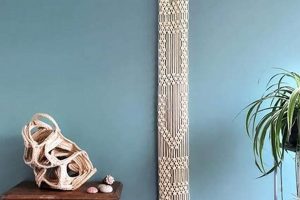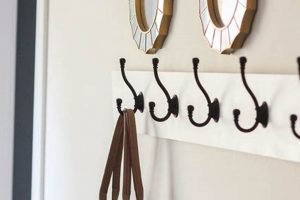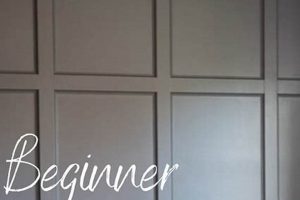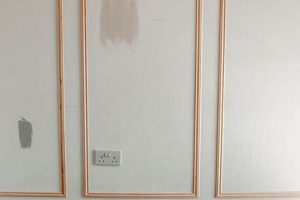The creation of textured wall dcor using plaster, undertaken as a do-it-yourself activity, represents an increasingly popular method for personalizing interior spaces. This approach allows individuals to fashion unique, three-dimensional artwork directly onto walls, employing readily available materials and techniques. Examples range from simple geometric patterns to intricate floral reliefs, each reflecting the creator’s individual aesthetic.
The appeal of this artistic endeavor lies in its accessibility and transformative potential. It offers a cost-effective alternative to commercially produced wall art while providing a tangible connection to the finished product. Historically, plasterwork has been a feature of architectural design, but its adaptation to smaller-scale, individual art projects democratizes the medium, allowing wider participation in the creation of aesthetically pleasing environments.
The following discussion will explore various techniques, material considerations, and design approaches relevant to executing this form of wall decoration. Emphasis will be placed on practical guidance and safety precautions to ensure successful implementation and lasting results.
Guidance for Plaster Wall Art Creation
The following recommendations aim to facilitate the successful execution of textured wall art projects. Adherence to these guidelines can mitigate common issues and enhance the final aesthetic.
Tip 1: Surface Preparation: Thoroughly clean and prime the wall surface prior to application. Ensure the wall is free of dust, grease, and loose paint. A suitable primer promotes adhesion and prevents moisture absorption into the substrate.
Tip 2: Plaster Consistency: Mix plaster to the appropriate consistency according to the manufacturer’s instructions. Avoid overly thick or thin mixtures, as these can lead to cracking or sagging. A smooth, spreadable consistency is generally desirable.
Tip 3: Layered Application: Apply plaster in thin, even layers. This technique minimizes the risk of cracking and allows for greater control over the final texture. Multiple thin coats are preferable to a single thick coat.
Tip 4: Tool Selection: Utilize a variety of tools, such as trowels, spatulas, and textured rollers, to achieve desired effects. Experiment with different tools on a test surface to determine their suitability for the intended design.
Tip 5: Time Management: Plaster has a limited working time. Plan the design and application process in advance and work efficiently. Avoid attempting overly complex designs without adequate experience.
Tip 6: Sealing and Protection: Once the plaster has fully cured, apply a sealant to protect the surface from moisture and abrasion. A suitable sealant enhances durability and simplifies cleaning.
Tip 7: Ventilation Considerations: Ensure adequate ventilation during the application and curing process. Plaster can release volatile organic compounds (VOCs), which can be harmful in poorly ventilated spaces.
The successful incorporation of these recommendations contributes to a durable and visually appealing outcome. Careful planning, meticulous execution, and appropriate material selection are paramount.
Subsequent sections will address design considerations and aesthetic principles applicable to this art form.
1. Material Selection
The selection of appropriate materials directly determines the aesthetic outcome, structural integrity, and longevity of plaster wall art. Plaster composition, aggregate type, and additives significantly influence texture, color, and resistance to environmental factors. For instance, using a gypsum-based plaster results in a softer, more easily carved surface, suitable for intricate detailing, while a lime-based plaster offers increased breathability and a natural resistance to mold, making it appropriate for humid environments. The addition of aggregates such as sand, marble dust, or fibers alters the plaster’s texture, workability, and structural strength. Improper material selection can lead to cracking, crumbling, or detachment from the wall surface.
Real-world examples illustrate the consequences of inappropriate material choices. A novice artisan attempting to create a highly textured relief with a plaster lacking sufficient binding agents may find the applied material prone to flaking and crumbling during the curing process. Conversely, employing a plaster formulated for exterior applications in an interior setting could result in excessive hardness and difficulty in achieving desired decorative effects. Understanding the specific properties of each material, including its setting time, shrinkage rate, and adhesion characteristics, is crucial for successful execution. Furthermore, compatibility with existing wall substrates must be assessed to prevent adverse chemical reactions or structural weaknesses.
In summary, informed material selection is not merely a preliminary step, but a fundamental aspect of plaster wall art creation that dictates the success of the project. Addressing the specific project goals and environmental conditions with informed material choices will yield durable and aesthetically pleasing outcomes. Lack of awareness or inappropriate substitution can compromise the artwork’s structural stability and visual appeal, necessitating costly repairs or complete re-applications.
2. Surface Preparation
Surface preparation represents a critical initial phase in the creation of textured wall art, directly impacting the adhesion, longevity, and overall aesthetic quality of the finished piece. A meticulously prepared surface provides the necessary foundation for plaster to bond effectively, preventing premature failure and ensuring the intended design is accurately realized. The failure to properly prepare the surface is a common cause of disappointment and rework in wall art projects.
- Cleaning and Degreasing
The removal of dirt, dust, grease, and other contaminants is essential for achieving optimal plaster adhesion. These substances can create a barrier between the plaster and the substrate, leading to delamination or cracking over time. In residential settings, kitchens and bathrooms often require thorough degreasing due to accumulated cooking residue or soap scum. Failure to adequately clean the surface results in compromised adhesion and a reduced lifespan for the wall art.
- Repairing Imperfections
Addressing cracks, holes, or unevenness in the wall surface is necessary to provide a smooth and consistent base for the plaster. Minor imperfections can be filled with patching compound, while larger issues may require more extensive repairs. Neglecting these repairs will lead to visible flaws in the finished artwork and potential structural weaknesses. For instance, applying plaster over a pre-existing crack will likely result in the crack reappearing through the new finish.
- Priming for Adhesion
Applying a primer specifically designed for plaster or textured coatings creates a suitable bonding surface. Primers enhance adhesion, improve coverage, and prevent the substrate from absorbing moisture from the plaster too quickly, which can lead to cracking or uneven curing. The selection of an appropriate primer is determined by the substrate material, such as drywall, plaster, or concrete. Skipping this step significantly increases the risk of plaster failure and diminishes the overall quality of the artwork.
- Ensuring Structural Integrity
Evaluating the structural integrity of the existing wall is essential. Walls exhibiting signs of water damage, mold growth, or significant deterioration require professional assessment and repair before any plaster application. Attempting to apply plaster over an unstable surface compromises the integrity of the entire artwork, potentially leading to collapse or further damage to the underlying structure. Failure to address underlying structural issues can result in hazardous conditions and costly repairs.
These elements of surface preparation demonstrate its pivotal role in the successful realization of decorative wall art. By prioritizing thorough cleaning, careful repair, appropriate priming, and structural assessment, individuals undertaking such projects can significantly enhance the durability, visual appeal, and long-term performance of their artwork, avoiding common pitfalls and maximizing the creative potential of this artistic endeavor.
3. Design Complexity
Design complexity in the context of do-it-yourself plaster wall art refers to the intricacy of the planned artistic composition and the technical demands it places on the creator. It ranges from simple, repetitive patterns to elaborate, multi-layered reliefs, each requiring varying levels of skill, time investment, and material resources. Design complexity directly influences the feasibility of a project for an individual with limited experience.
- Pattern Repetition and Symmetry
The degree to which a design relies on repeating elements or symmetrical arrangements significantly affects its complexity. Simple, repeating geometric patterns are typically easier to execute, as they require mastering a single motif. More complex patterns with variations in scale, orientation, or material demand greater precision and meticulous planning. An example includes a basic chevron pattern compared to an intricate Islamic geometric design; the latter necessitates careful measurement and precise execution to maintain visual harmony. Misalignment or inconsistencies in complex patterns become readily apparent, detracting from the overall aesthetic.
- Layering and Depth
The addition of multiple layers of plaster to create depth and three-dimensionality increases design complexity. Each layer requires careful application, curing time, and potentially, additional detailing. The creation of a bas-relief sculpture, for instance, involves building up layers of plaster to gradually reveal the desired form. Inadequate planning or execution of layering can result in uneven surfaces, obscured details, or structural instability. The interplay of light and shadow on layered designs also necessitates consideration, requiring an understanding of how texture and form interact with illumination.
- Detailing and Texture Variety
The incorporation of fine details and varied textures introduces another layer of complexity. Highly detailed designs often require specialized tools and techniques, such as carving, stenciling, or texturing with specific implements. The creation of realistic floral motifs, for example, demands skillful rendering of petals, leaves, and stems. Conversely, a design featuring a range of textures, from smooth polished surfaces to rough, organic forms, necessitates mastery of different plastering techniques. Inadequate skill in detailing can result in a design that appears amateurish or unfinished.
- Color Integration
The introduction of color, whether through the use of pigmented plaster, surface painting, or other decorative finishes, adds complexity to the design process. Achieving consistent color distribution, harmonious color combinations, and durable colorfastness requires careful planning and execution. The application of faux finishes, such as marbling or antiquing, demands specialized knowledge and techniques. Improper color selection or application can detract from the overall design, creating a visually jarring or unbalanced effect. Furthermore, the long-term durability of the applied colors must be considered, as fading or discoloration can diminish the artwork’s visual appeal over time.
These factors, when considered collectively, emphasize that the feasibility of a decorative wall art project hinges significantly on aligning design complexity with the creator’s skill level and available resources. While ambitious designs may be appealing, a more straightforward, well-executed concept often yields a more satisfying result for individuals new to this artistic medium. As experience grows, designs can progressively incorporate increased complexity, leading to more intricate and personalized wall decorations.
4. Application technique
The application technique is inextricably linked to the success of do-it-yourself plaster wall art. It is the conduit through which the chosen design materializes, directly influencing the texture, depth, and overall aesthetic impact of the artwork. Inadequate or inappropriate application methods frequently lead to undesirable outcomes, such as cracking, uneven surfaces, or a loss of intended detail. For instance, applying plaster in excessively thick layers can result in shrinkage cracks as the material dries, undermining both the structural integrity and visual appeal of the piece. Conversely, insufficient plaster application may fail to fully realize the desired texture or relief. The chosen technique, therefore, serves as a critical determinant in the ultimate quality of the finished work, serving as the bridge between creative vision and tangible reality.
Specific application methods cater to different design objectives. Troweling, for example, is commonly employed to achieve smooth, polished surfaces, particularly with Venetian plaster. This technique demands consistent pressure and overlapping strokes to minimize imperfections and create a seamless finish. Conversely, stippling or sponging techniques are used to impart textured effects, introducing subtle variations in surface depth and light reflection. Creating raised relief patterns requires a more sculptural approach, often involving the application of multiple layers and the use of carving tools to refine the form. Each method necessitates a distinct skill set and a thorough understanding of the material’s properties. Furthermore, environmental factors, such as temperature and humidity, can significantly impact plaster’s workability and drying time, requiring adjustments in technique to compensate for these variables.
In summary, the connection between application technique and the realization of aesthetically pleasing and durable plaster wall art cannot be overstated. Mastering the appropriate techniques for a given design and material is paramount to achieving a successful outcome. Diligence in practicing these methods, coupled with an awareness of environmental influences, empowers individuals to transform their creative visions into tangible works of art, enriching their living spaces with personalized and visually compelling decor. The application process is not merely a means to an end; it is an integral part of the artistic endeavor itself, shaping the final expression and character of the plaster wall art.
5. Curing process
The curing process, an essential phase in the creation of plaster wall art, involves the chemical and physical transformations that harden and strengthen the applied plaster. It is the period during which the plaster sets, loses excess moisture, and achieves its final structural integrity. Inadequate curing can lead to a range of problems, including cracking, crumbling, and a diminished aesthetic quality of the finished artwork. For example, if plaster dries too rapidly, the surface may develop hairline fractures due to uneven shrinkage. Understanding the specific curing requirements of different plaster types is therefore crucial for successful project completion.
The duration and conditions of the curing period vary depending on the plaster composition, ambient temperature, and humidity levels. Gypsum plasters typically cure relatively quickly, whereas lime-based plasters require a more extended curing time, often spanning several weeks, to fully carbonate. Maintaining consistent environmental conditions during curing is also important. Fluctuations in temperature or humidity can introduce stress into the plaster, increasing the risk of cracking. To mitigate these risks, measures such as controlled ventilation, misting the surface with water, or covering the artwork with plastic sheeting may be implemented to regulate the drying rate. Failure to control these factors can lead to aesthetic flaws or structural weaknesses that compromise the artwork’s longevity.
In conclusion, the curing process is not merely a passive waiting period but an active stage requiring careful management to ensure the successful transformation of applied plaster into durable and visually appealing wall art. Paying meticulous attention to curing conditions, adhering to recommended timelines, and understanding the specific needs of the chosen plaster type are paramount. These efforts enhance the art piece and significantly improve its longevity, preserving the artistic endeavor for years to come.
6. Sealing methods
Sealing methods constitute a critical final stage in the creation of plaster wall art, directly impacting its long-term durability and aesthetic preservation. The application of a sealant creates a protective barrier that shields the porous plaster surface from moisture, dirt, and abrasion. Without adequate sealing, the artwork is susceptible to staining, fading, and physical damage, diminishing its visual appeal and lifespan. For example, unsealed plaster in a bathroom is prone to mold growth and water damage, necessitating frequent cleaning and potential repairs. The choice of sealing method depends on the type of plaster used, the intended environment, and the desired aesthetic outcome. Ignoring this step significantly compromises the investment of time and resources dedicated to the artwork’s creation.
Specific sealing products and techniques cater to different needs. Acrylic sealers, for instance, provide a durable and water-resistant finish, suitable for high-traffic areas or environments with elevated humidity levels. Wax-based sealants, often used with Venetian plaster, impart a lustrous sheen and enhance the depth of color. Penetrating sealers, on the other hand, absorb into the plaster, providing protection from within without altering the surface appearance. The selection of an inappropriate sealant can have detrimental effects. Applying a non-breathable sealer to a lime-based plaster, for example, can trap moisture within the material, leading to spalling or delamination. Therefore, careful consideration of material compatibility and environmental factors is crucial for effective sealing. Real-world examples highlight the importance of proper sealing practices, such as the use of marine-grade sealants on plaster wall art located near coastal areas, providing enhanced protection against salt spray and atmospheric corrosion. Similarly, in commercial settings, durable, abrasion-resistant sealants are preferred to withstand the rigors of daily use. These sealants are also very important for diy plaster wall art for people to sell their product because it will show the quality of the work.
In summary, the application of appropriate sealing methods is indispensable for ensuring the longevity and aesthetic integrity of plaster wall art. This final step serves as a safeguard against environmental damage and wear, preserving the artistic creation for extended enjoyment. Understanding the properties of different sealants, considering their compatibility with the plaster type, and carefully executing the application process are essential for maximizing the protective benefits of this technique. Neglecting this crucial step can negate much of the effort invested in creating the artwork, leading to premature degradation and diminished visual appeal.
7. Safety protocols
Adherence to established safety protocols is a non-negotiable aspect of creating do-it-yourself plaster wall art. The inherent properties of plaster materials, coupled with the tools and techniques employed, present potential hazards that necessitate strict adherence to safety guidelines. Failure to observe these protocols can result in personal injury, property damage, or long-term health issues. The dust generated during mixing and sanding operations, for instance, can irritate the respiratory system and, with prolonged exposure, contribute to the development of silicosis or other lung diseases. Similarly, improper handling of tools such as trowels, knives, or power sanders can lead to cuts, lacerations, or more severe injuries. Therefore, a comprehensive understanding of safety protocols is paramount to mitigating these risks.
Practical application of safety protocols in wall art creation manifests in several key areas. Respiratory protection, achieved through the use of properly fitted respirators or dust masks, is essential during any activity that generates airborne particles. Eye protection, provided by safety glasses or goggles, safeguards against plaster splashes and flying debris. Skin protection, accomplished through the use of gloves and appropriate clothing, minimizes direct contact with plaster, which can cause skin irritation or allergic reactions in some individuals. Adequate ventilation is also crucial, ensuring that airborne contaminants are effectively removed from the work area. Furthermore, the proper handling and storage of plaster materials, as well as the safe operation of power tools, are integral components of a comprehensive safety plan. Real-world examples frequently demonstrate the consequences of neglecting these precautions, with incidents ranging from minor skin irritations to severe respiratory ailments and accidental injuries.
In summary, safety protocols are not merely a set of recommended practices but a fundamental requirement for the responsible and successful execution of do-it-yourself plaster wall art projects. The challenges associated with this endeavor lie in consistently applying these protocols and adapting them to the specific materials, techniques, and environmental conditions involved. By prioritizing safety at every stage of the process, individuals can minimize the risks and maximize the creative potential of this artistic pursuit, ensuring a safe and enjoyable experience.
Frequently Asked Questions
The following addresses common inquiries regarding the creation of textured wall dcor using plaster, intended for individuals undertaking such projects. These answers are designed to provide clarity and guidance on fundamental aspects of this artistic endeavor.
Question 1: What plaster type is most suitable for beginners?
Gypsum-based plaster is often recommended for novice artisans due to its ease of mixing, relatively fast setting time, and forgiving nature. Its workability makes it conducive to learning basic techniques. However, lime-based plasters offer greater breathability and mold resistance, qualities valued in specific environments.
Question 2: How is cracking prevented in large plaster wall art installations?
Cracking is mitigated through proper surface preparation, including priming, and the application of plaster in thin, successive layers. Reinforcement with fiberglass mesh can provide additional structural support. Maintaining consistent environmental conditions during curing is also critical.
Question 3: What safety precautions should be observed when working with plaster?
Respiratory protection, such as a properly fitted respirator, is essential to prevent inhalation of plaster dust. Eye protection, in the form of safety glasses or goggles, is necessary to guard against splashes. Skin protection, achieved through gloves and appropriate clothing, minimizes the risk of irritation.
Question 4: How long should plaster wall art cure before sealing?
The curing time varies depending on the plaster type and environmental conditions. Gypsum-based plasters typically require several days to a week, while lime-based plasters may necessitate several weeks. The plaster should be fully dry and hardened before sealing.
Question 5: Can existing painted walls be directly plastered over?
While technically possible, direct application onto painted surfaces is not generally recommended. Existing paint can impede plaster adhesion and potentially lead to delamination. Removal of loose paint and application of a suitable primer are preferable.
Question 6: What methods are effective for cleaning plaster wall art?
Gentle dusting with a soft cloth or brush is suitable for routine cleaning. For more stubborn stains, a slightly damp sponge can be used, taking care to avoid excessive moisture. Harsh chemicals or abrasive cleaners should be avoided.
In summary, careful planning, adherence to safety protocols, and a thorough understanding of material properties are essential for successful wall art creation. These guidelines mitigate common issues and enhance the final aesthetic.
The subsequent section will explore advanced techniques and considerations for experienced artisans.
Conclusion
The preceding discussion has explored various facets of DIY plaster wall art, encompassing material selection, surface preparation, application techniques, curing processes, and safety protocols. Emphasis has been placed on the importance of meticulous planning, informed decision-making, and adherence to established guidelines to achieve durable and aesthetically pleasing results. The creative potential of this medium has been highlighted, emphasizing its capacity for personalizing interior spaces and expressing individual artistic vision.
The enduring appeal of DIY plaster wall art lies in its accessibility and transformative power. Mastery of the techniques outlined herein empowers individuals to create bespoke decorative elements, enriching their environments with unique and enduring works of art. Continued exploration and refinement of these skills will undoubtedly contribute to the evolution and appreciation of this art form. The benefits of this endeavor is by being able to sell DIY Plaster Wall Art that will show the value and uniqueness of the product.







